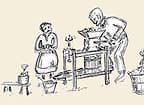|
The Twice Lost Treasure
The Story of Batiste Madalena
by
A Warning — There are many tales of treasure: lost
sunken and buried. This is a tale of a great treasure lost, not once, but twice
right here in Rochester.
It may seem sad, it may seem frustrating and it may make you want to ask "Why
didn't somebody do something?" Perhaps its best for those of you who get easily
upset not to proceed, instead, skip to the next chapter. However, it you're
still interested you may well be amazed at this tale of twice lost treasure.
The Gift — Our tale begins on August 5th, 1919. A black-tie dinner was being
given by Mr. George Eastman at the Genesee Valley Club for the members of the
National Association of the Motion Picture Industry. There Dr. Rush Rhees,
president of the University of Rochester, made a remarkable announcement. He
told the
audience that Mr. Eastman was giving the University three and a half million
dollars. This handsome gift was to be used to build an elaborate motion picture
theatre and a school of music, to be named Kilbourn Hall, in honor of the
donor's mother. The funds were divided as follows: $481,000 for the site, building,
and equipment. The remaining $2,139,000 was to be used for the School of Music
endowment.
A Showcase — Press reports across the nation described the theatre as "the
last word in stability of construction, beauty of material and design." Writers
exhaused their supply of superlatives when the School of Music opened in September
of 1921 and the Eastman Theatre opening followed in 1922. George not only
wanted his new theatre to bring music to the masses of Rochester, but he also
"envisioned
his theatre as a showcase for the newest form of popular entertainment — motion
pictures."
It goes without saying that the theatre was "supremely fitting" for
the showing of films. After all, it was the manufacture of sprocketed film
that allowed
Hollywood to capture those silver dreams for the screens of the world.
Details — Mr. Eastman personally saw to many
of the amenities of the elaborate edifice. He was meticulous about the placement
of seven brass-framed
theatre
sign cases flanking the Gibbs and East Main Street entrances. These cases would
hold the ballyhoo broadsides sent along with the film to promote the attraction.
Its interesting to note that even in this detail George Eastman felt a special
obligation to the arts. He disliked the Hollywood film ads, feeling they were
cheap looking and poorly done. Thus, he directed his firm's advertising manager
to find a local talent who could produce artisitic and attractive billboard
posters for his theatre.
B. F. Madalena — A city-wide talent search
was to end with Batiste F. Madalena, a young art student, recently arrived
from Italy. In his early 20's, Batiste
had just graduated from the Mechanics Institute (later Rochester Institute
of Technology) and had accepted a scholarship to attend the Art Students League
in New York City. It may have been George himself that persuaded Madalena that
he could postpone his further art education to accept a commission doing
commercial art for the Eastman Theatre.
A Priceless Collection — The young Madalena's instructions were both
simple and yet demanding. For each film he was to produce seven 22 by 44 inch
posters,
each different, that could be easily spotted and read from the trolleys passing
the intersection. For the next four years Batiste labored at his craft. Seven
posters each week, for 50 weeks, that's 350 per year. Starting in 1924, the
commission expired in 1928 with the leasing of the theatre to the Paramount
Publix chain. By then Madalena had created an estimated total of 1400 original
paintings.
These represented minor masterpieces which detailed and documented the early
days of the film in our nation. His works were certainly the most definitive
set of original film posters in America. They were a wonderful and priceless
collection.
Style — His posters were vibrant and alive. Batiste
was able to capture the essence of a movie with a minimum of clutter. Using
tempera paint on poster
board he created a mood that demanded your attention. The labels and captions
on the posters were also well done. They sent their message to the viewer but
did not interfere with the illustration. As with most gifted artists he exerted
great control over the medium with which he worked. And, although he produced
a variety of styles, his work was so distinctive that you could always identify
it as a Madalena.
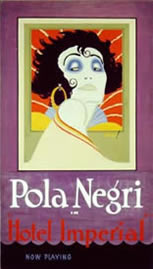
The Silver Screen — The industry serving the
silver screen produced many great films that became the subject of Mr. Madalena's
creative artwork. The Son
of the Sheik with Rudolph Valentino, Laugh Clown Laugh with Lon
Chaney, and The
Freshman starring Harold Lloyd were among his subjects. He painted the
Westerns such as The Covered Wagon, the mysteries including The
Haunted House, and romaances with John Barrymore in Beau Brummel.
His works spoke in a manner which was far
more powerful than mere words. The historical masterpieces of the early screen's
golden age were also captured by the young artist. He was master at conveying
mood and plot in just a few bold brush strokes.
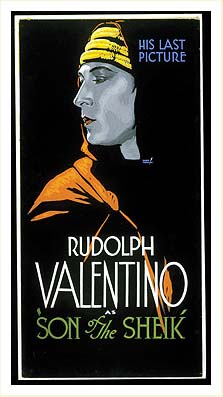
Following his termination as
the Eastman artist, Batiste opened a small commercial art shop near Main
Street. He never did follow through on his invitation for
advanced art education in New York City. It was a bleak, windy and rainy
evening in late October of 1928. Mr. Madalena was riding his bicycle, using
Swan Street
as a shortcut home from his studio, when he saw something that made his body
wrench to a stop. He spotted a truly horrendous sight.
Trashed Treasure — Next to the Eastman's rear
entrance, scattered across the wet pavement, were hundreds of Batiste's paintings.
Parmount Publix, having
no use for them, simply had the treasure trashed. Thus, a great artistic treasure
was lost. Batiste, stricken with heartache, gathered up as many as he could
salvage from the sodden mass. Most of the tempera-painted art work, easily
moistened by the rain, was streaked and mottled beyond repair.
Restoration — Bursting into his home he called
for Margaret, his wife, to help him with the almost hopeless task of drying
and
restoration. Hour after hour
they labored to carefully dry the damp poster board. It was necessary to
use a warm iron to reseal paint that had begun to peel. Then, using books and
other weights. they spread the works across the kitchen and living room floors,
table tops and other available surfaces to flatten and dry. The Madalenas salvaged
about 225 out of 1400, a mere handul. During the following days he contructed
a number of wooden crates. Into these he placed all that
remained of four years of his life's work. Each of the crated posters were
then placed in their attic where they were to gather dust for the next 45
years.
Coincidence One — Mr. Madalena retired at age 63
from his firm, B & M Designs, in 1965. We might have heard no more of him had
it not been for a series of
coincidental events. The first was an exhibition in the lobby of the Lincoln
Rochester Trust Company on East Main Street of works of some local artists
in 1973.
The Madalena's daughter Rita entered a number of her father's posters in the
exhibit.
Coincidence Two — Attending a city convention
was Steven Katten, a documentary filmmaker. Chance, and a break from the convention
would place him in the lobby
of the bank where he would discover Batiste Madalena's striking theatre posters.
Upon returning to Los Angeles, Katten discussed the dynamic quality of the
paintings with his wife Judith. The unfortgetable images would haunt him for
several
years. Thus, in 1979 he contacted Mr. Madalena and arranged to buy the entire
collection.
Twice Lost — Most of the posters of Batiste Madalena had been thrown out on
the street in Rochester. Now the remaining ones that Batiste and Margaret had
saved left Rochester.
High Praise — In 1981, Anthony Slide, former
resident historian for the Academy of Motion Piccture Arts and Sciences paid
high tribute to Madalena saying,
"Perhaps best of all Batiste Madalena's posters capture the glamour of
an era of film history which is past and which no written word can adequately
recapture."
The posters now tour the southwest, displayed in museums throughout California.
They have even come East as a part of an exhibit on Hollywood at the Smithsonian.
The tale of the posters also came to Charles Kuralt's attention. On his "Sunday
Morning" television show he referred to them as "…the greatest
movie posters ever created."
Time magazine termed the posters as "the kind of movie colorizing
that deserves sustained applause." They reported that Madalena had wanted
to become "the
best darn poster artist in the city," and had now "become recognized
as one of the best in the world." A mass-produced poster of the 1942 film Casablanca,
recently sold for $17,000. One of Batiste's posters sold for $9,500 in 1988,
the year he passed away.
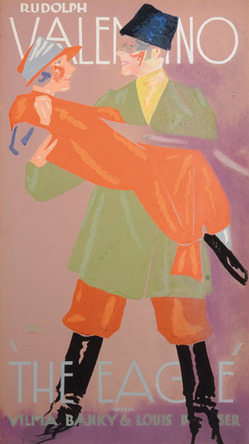
An Alternative — In displaying Madalena's works,
Steven and Judith Katten have made our Rochester artist internationally famous.
It was, however, in
California, not New York, that the true value of the paintings was recognized.
The next time you go by the Eastman Theatre and see those seven poster display
cases, remember Batiste Madalena, and how our city twice lost his treasure.
If
you can't get to California to view our lost treasures, there is an alternative.
In
1986
some
twenty-four
full-color
posters were reproduced
in
the book Movie
Posters: The Paintings of Batiste Madalena. New York City art publisher,
Harry N. Abrams, publishes the paperback book for $14.95. It's worth the
price.
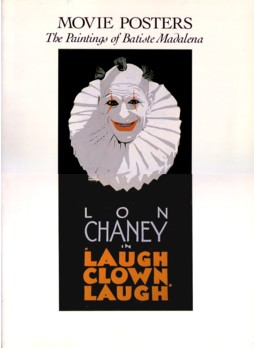
|

